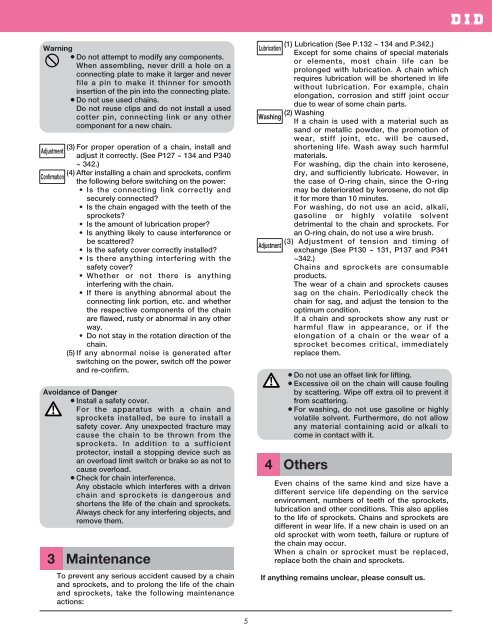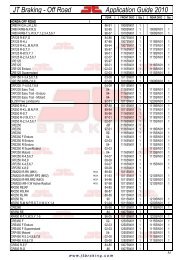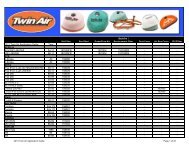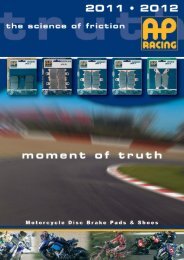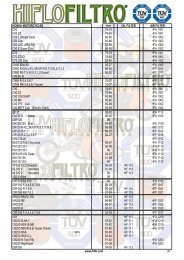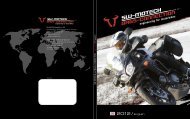DID 60 standard roller chain - Big Bike Webshop
DID 60 standard roller chain - Big Bike Webshop
DID 60 standard roller chain - Big Bike Webshop
You also want an ePaper? Increase the reach of your titles
YUMPU automatically turns print PDFs into web optimized ePapers that Google loves.
Warning<br />
¡Do not attempt to modify any components.<br />
When assembling, never drill a hole on a<br />
connecting plate to make it larger and never<br />
file a pin to make it thinner for smooth<br />
insertion of the pin into the connecting plate.<br />
¡Do not use used <strong>chain</strong>s.<br />
Do not reuse clips and do not install a used<br />
cotter pin, connecting link or any other<br />
component for a new <strong>chain</strong>.<br />
Adjustment<br />
Confirmation<br />
(3) For proper operation of a <strong>chain</strong>, install and<br />
adjust it correctly. (See P127 ~ 134 and P340<br />
~ 342.)<br />
(4) After installing a <strong>chain</strong> and sprockets, confirm<br />
the following before switching on the power:<br />
• Is the connecting link correctly and<br />
securely connected?<br />
• Is the <strong>chain</strong> engaged with the teeth of the<br />
sprockets?<br />
• Is the amount of lubrication proper?<br />
• Is anything likely to cause interference or<br />
be scattered?<br />
• Is the safety cover correctly installed?<br />
• Is there anything interfering with the<br />
safety cover?<br />
• Whether or not there is anything<br />
interfering with the <strong>chain</strong>.<br />
• If there is anything abnormal about the<br />
connecting link portion, etc. and whether<br />
the respective components of the <strong>chain</strong><br />
are flawed, rusty or abnormal in any other<br />
way.<br />
• Do not stay in the rotation direction of the<br />
<strong>chain</strong>.<br />
(5) If any abnormal noise is generated after<br />
switching on the power, switch off the power<br />
and re-confirm.<br />
Avoidance of Danger<br />
¡Install a safety cover.<br />
For the apparatus with a <strong>chain</strong> and<br />
sprockets installed, be sure to install a<br />
safety cover. Any unexpected fracture may<br />
cause the <strong>chain</strong> to be thrown from the<br />
sprockets. In addition to a sufficient<br />
protector, install a stopping device such as<br />
an overload limit switch or brake so as not to<br />
cause overload.<br />
¡Check for <strong>chain</strong> interference.<br />
Any obstacle which interferes with a driven<br />
<strong>chain</strong> and sprockets is dangerous and<br />
shortens the life of the <strong>chain</strong> and sprockets.<br />
Always check for any interfering objects, and<br />
remove them.<br />
3<br />
Maintenance<br />
To prevent any serious accident caused by a <strong>chain</strong><br />
and sprockets, and to prolong the life of the <strong>chain</strong><br />
and sprockets, take the following maintenance<br />
actions:<br />
Lubrication<br />
Washing<br />
Adjustment<br />
4<br />
(1) Lubrication (See P.132 ~ 134 and P.342.)<br />
Except for some <strong>chain</strong>s of special materials<br />
or elements, most <strong>chain</strong> life can be<br />
prolonged with lubrication. A <strong>chain</strong> which<br />
requires lubrication will be shortened in life<br />
without lubrication. For example, <strong>chain</strong><br />
elongation, corrosion and stiff joint occur<br />
due to wear of some <strong>chain</strong> parts.<br />
(2) Washing<br />
If a <strong>chain</strong> is used with a material such as<br />
sand or metallic powder, the promotion of<br />
wear, stiff joint, etc. will be caused,<br />
shortening life. Wash away such harmful<br />
materials.<br />
For washing, dip the <strong>chain</strong> into kerosene,<br />
dry, and sufficiently lubricate. However, in<br />
the case of O-ring <strong>chain</strong>, since the O-ring<br />
may be deteriorated by kerosene, do not dip<br />
it for more than 10 minutes.<br />
For washing, do not use an acid, alkali,<br />
gasoline or highly volatile solvent<br />
detrimental to the <strong>chain</strong> and sprockets. For<br />
an O-ring <strong>chain</strong>, do not use a wire brush.<br />
(3) Adjustment of tension and timing of<br />
exchange (See P130 ~ 131, P137 and P341<br />
~342.)<br />
Chains and sprockets are consumable<br />
products.<br />
The wear of a <strong>chain</strong> and sprockets causes<br />
sag on the <strong>chain</strong>. Periodically check the<br />
<strong>chain</strong> for sag, and adjust the tension to the<br />
optimum condition.<br />
If a <strong>chain</strong> and sprockets show any rust or<br />
harmful flaw in appearance, or if the<br />
elongation of a <strong>chain</strong> or the wear of a<br />
sprocket becomes critical, immediately<br />
replace them.<br />
¡Do not use an offset link for lifting.<br />
¡Excessive oil on the <strong>chain</strong> will cause fouling<br />
by scattering. Wipe off extra oil to prevent it<br />
from scattering.<br />
¡For washing, do not use gasoline or highly<br />
volatile solvent. Furthermore, do not allow<br />
any material containing acid or alkali to<br />
come in contact with it.<br />
Others<br />
Even <strong>chain</strong>s of the same kind and size have a<br />
different service life depending on the service<br />
environment, numbers of teeth of the sprockets,<br />
lubrication and other conditions. This also applies<br />
to the life of sprockets. Chains and sprockets are<br />
different in wear life. If a new <strong>chain</strong> is used on an<br />
old sprocket with worn teeth, failure or rupture of<br />
the <strong>chain</strong> may occur.<br />
When a <strong>chain</strong> or sprocket must be replaced,<br />
replace both the <strong>chain</strong> and sprockets.<br />
If anything remains unclear, please consult us.<br />
5


